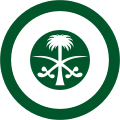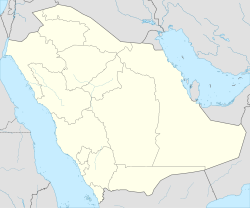Riyadh Air Base (closed 2021)
| Riyadh Air Base | |
|---|---|
قاعدة الملك سلمان الجوية | |
| Riyadh, Riyadh Province in Saudi Arabia | |
| Site information | |
| Type | Defunct |
| Owner | Ministry of Defense |
| Operator | Royal Saudi Air Force |
| Location | |
| Coordinates | 24°42′35″N 46°43′31″E / 24.70972°N 46.72528°E |
| Area | 45sqkm[1] |
| Site history | |
| Built | 1945 |
| In use | 2023 |
| Airfield information | |
| Elevation | 635 metres (2,083 ft) AMSL |
Riyadh Air Base, officially known as Riyadh International Airport before it’s conversion in 1983, was one of the first airports of Saudi Arabia located within Riyadh. It was the original airport serving the city before the construction of King Khalid International Airport, then transitioning into an air base. It was demolished between 2021-22 to make way for King Salman Park.
History
[edit]In 1945, the Royal Terminal and the Passenger Terminal was opened by King Sultan bin Abdulaziz. By 1954, passenger numbers had grown to 5900, which prompted King Saud to establish expansion goals. In 1956, he laid a stone in the foundation, and the expansion began in 1957. Two new lounges, a reception, and departure hall was completed in 1962, totaling the airport area to 9,300 square meters.[2] During the time, passport services were simple, as reservations for travel was done manually. Passports were also applied to international travelers at a few counters, which caused crowding during the beginning of the airport. Riyadh Airport first operated a wide crushed-rock base runway, which measured approximately 1950 meters long and 45 meters. Its facilities included a hanger under construction, administration, smaller buildings, and accomodations for 50 airforce personnel. There were also grade 1120 oil available in drums on site. There was a former camp which could accomodate 30 personnel.[3] On July 1958, a new asphalt runway commenced construction, measuring approximately 2743 meters long and 45 meters wide. It consisted of 1.5 meters of asphalt surfacing and a crushed rock end.[4] The rapid urban extension of new neighborhoods begun emerging outside Riyadh and towards the airport. By the 1970s, the airport was close to residential neighborhoods, such as the Malaz neighborhood.[5]
On 2009, the construction of a new runway 15/33 was partaken by Associated Engineers Company and completed in 2011. This also included the construction of a highway that went over the airport grounds, and phasing out runway 12/30. The project costed 200 million dollars USD. [6]
Reason for closure
[edit]Originally, the airport was located at a far distance from the city as shown in a 1966 declassified satellite image of Riyadh. However, soon by the late 1970s, the airport was surrounded by housing, meaning the construction for a new airport was necessary. In 1983, King Khalid International Airport was opened, and the airport was converted into a military airbase. The airbase was used until it was demolished in 2020-2021.[5]
Runway Layout
[edit]Before the early to mid-1960s, there were two parallel runways in Riyadh International Airport. There was a 9000 feet runway numbered 12L/30R and another shorter runway (6000-7000 feet runway) numbered 12R/30L. The shorter runway by the 1960s had closed, though in 1966 the 9000 feet runway still showed Runway 30R instead of 30. By 1966, Runway 01/19 was finished, though it still needed runway markings. By the 1980s, Runway 01/19 was 13,500 feet meanwhile Runway 12/30 was 11,800 feet. In 2009-2010, a new 10,200 feet runway numbered 15/33 was built. The old runway 12/30 had closed after this.[7]
Accidents and incidents
[edit]- 19 August 1980: Saudia Flight 163, a Lockheed L-1011-200 operated by Saudia from Karachi International Airport (now Jinnah International Airport) in Karachi, Pakistan to Jeddah International Airport in Saudi Arabia via Riyadh, suffered a fire just after takeoff from Riyadh. However, due to poor coordination and inexperience, the crew used the entire length of runway 01 instead of performing an emergency stop, and parked on a taxiway at the end of the runway. Additionally, the crew failed to switch off the engines immediately after coming to a stop, preventing firefighters from approaching. The engines were shut down three minutes later, but no evacuation was attempted (likely due to the crew and passengers being either incapacitated or dead from smoke inhalation) and firefighters were unable to gain access into the interior of the aircraft for an additional 23 minutes. The aircraft burst into flames three minutes after firefighters' entry, and all 301 persons aboard died. This was the most lethal accident involving an L-1011 and the deadliest aviation accident in Saudi Arabia as of 2021.[citation needed]
- 24 February 1985: An RSAF KC-130H Hercules aerial refueling tanker was too high when approaching the airport's runway 01. The air traffic controller on duty requested that the aircraft make a 360-degree turn to decrease speed and altitude. However, the pilot instead decided to lose altitude by side-slipping, and the shifting of the fuel load caused the pilot to lose control and crash just short of the runway. All eight crew members died.[8]
References
[edit]- ^ "King Salman Airbase project". Middle East Tenders. Retrieved 8 May 2025.
- ^ "Riyadh Air Base". King Saud Foundation (in Arabic). Retrieved 21 May 2025.
- ^ "Department of the Army Middle East Airfield Study (MEAFS), Volume 1" (PDF). Office of the Chief of Engineers, U.S. Army. 1 July 1958. Retrieved 16 June 2025.
- ^ "Middle Eastern Airfield Report Volume 2 | Page 17" (PDF). apps.dtic.mil. Retrieved 13 June 2025.
- ^ a b Al-Duwaihi, Hamoud (19 February 2016). "Old Riyadh Airport: A Witness to Simple Beginnings and Travelers' Memories". Al Riyadh Newspaper (in Arabic). Retrieved 21 May 2025.
- ^ "Airports Construction". AEC Saudi Arabia Ltd. Retrieved 15 June 2025.
- ^ "Riyadh, Saudi Arabia – 18 May 1966". Space From Space. Retrieved 10 May 2025.
- ^ Ranter, Harro. "ASN Aircraft accident Lockheed KC-130H Hercules 1620 Riyadh Air Base (XXN)". Aviation Safety Network. Retrieved 2019-06-14.


